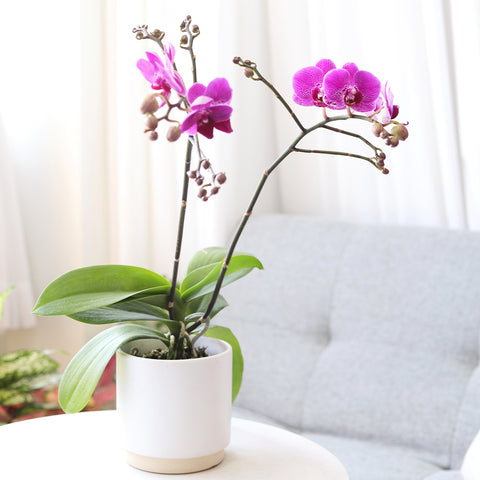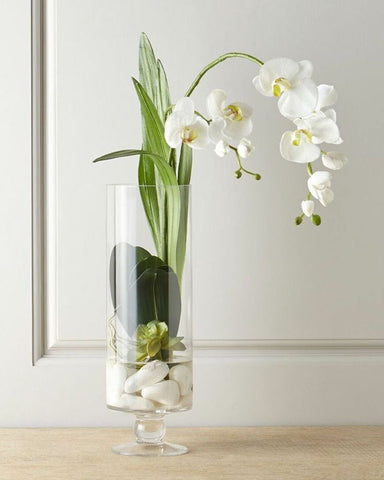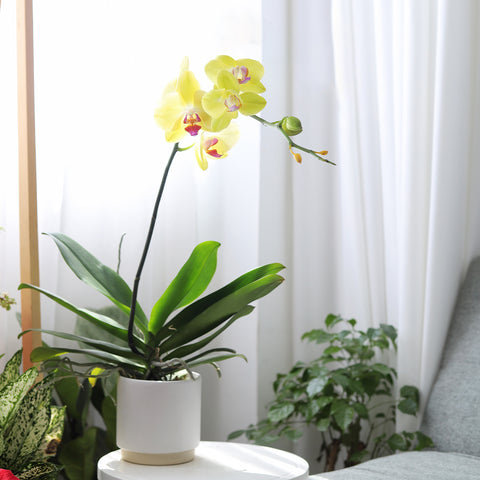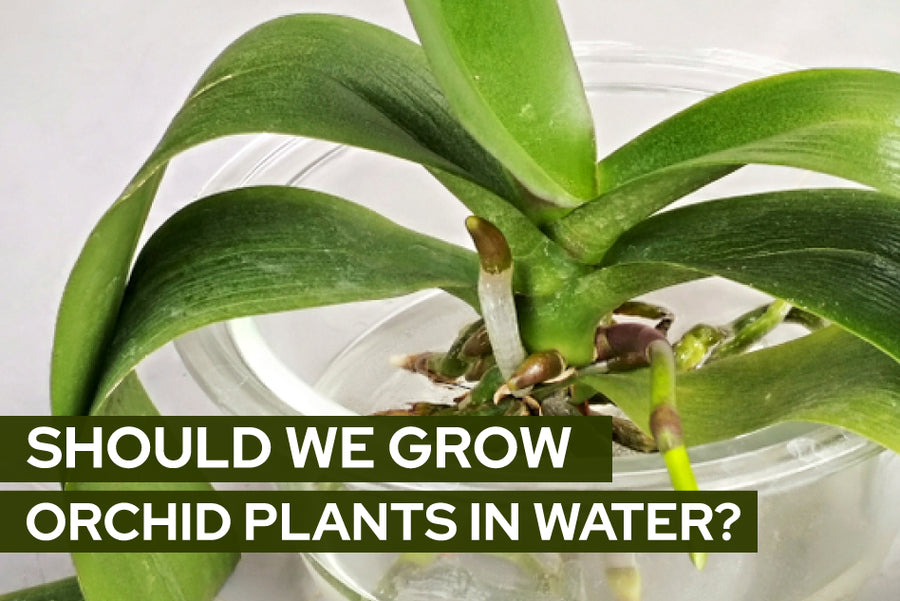Orchids are a type of flowering plant belonging to the family Orchidaceae. They are one of the most popular and diverse species of houseplants. Orchids are renowned for their lovely, lasting flowers, which come in various shapes, sizes, and colors. Orchids are usually epiphytic, which grows on other plants or objects like rocks and terrestrials. Orchids are among the largest families of flowering plants, with over 25,000 species and countless hybrids found in diverse habitats around the world. They can grow in different environments like tropical rainforests, forests with mild weather, grasslands, and even deserts. Places like Southeast Asia, Central and South America, and parts of Africa have lots of different kinds of orchids. Orchids are popular choices for both indoor and outdoor cultivation.
Orchids typically grow in a specialized orchid mix, which is a blend of materials that provide good drainage and aeration for the roots. This mix often includes components such as bark chips, sphagnum moss, perlite, charcoal, or coconut husk chips. The specific medium used can vary depending on the orchid species and its natural habitat, but the goal is to mimic the well-draining conditions found in their native environments.
However, some gardeners have tried cultivating orchids using water as a growing medium. While it's not the traditional method, it can be done with certain orchid species and under specific conditions. However, it's essential to research and understand the requirements of each orchid variety to ensure successful growth in water. Growing orchids in water requires careful monitoring to prevent root rot and ensure the plant receives adequate nutrients and oxygen.
Cultivation Of Orchids As Houseplants
The cultivation of orchids dates back thousands of years and has a rich history rooted in various cultures around the world. Orchids have been prized for their beauty and mystique, with different civilizations attributing different meanings and values to these exotic flowers. They were rare beauties that showed a symbol of wealth and high status. In the 19th and 20th centuries, advancements in horticulture and greenhouse technology made orchid cultivation more accessible to the general public. Today, orchids are one of the most popular and widely cultivated flowering plants, enjoyed by enthusiasts and gardeners around the world for their beauty, diversity, and adaptability to various growing conditions.
In any houseplant shop, typical orchids often stand out due to their unique and exotic appearance. Orchids are known for their elegant, long-lasting flowers that come in various colors and patterns. Their blooms can range from vibrant shades of pink, purple, and white to more unusual hues like green, yellow, and even blue. Orchid flowers typically have symmetrical shapes with intricate patterns and textures, adding to their allure. Orchid leaves are usually glossy and leathery, with elongated shapes and parallel veins running along their length. The leaves may grow in rosettes or along elongated stems, depending on the orchid species.
Orchid flowers are famous for staying fresh for weeks or even months if you take care of them well, making them a popular choice for gifts. Their long-lasting beauty means the recipient can enjoy them for a long time. Orchids have become a favorite gift for many occasions because they represent love and appreciation. Their stunning appearance reflects feelings of admiration and affection, making them a thoughtful choice for romantic gestures, friendships, or showing gratitude.
Are Orchids Easy-Growing Houseplants?
Orchids are often perceived as challenging to grow, primarily because they have specific requirements that differ from many other houseplants. They typically thrive in environments characterized by moderate humidity levels, excellent air circulation, and abundant, yet indirect, sunlight. These conditions mimic their natural habitats, often found in tropical rainforests and other humid regions around the world. Proper watering is crucial for orchids, as they prefer to dry out slightly between waterings to prevent root rot, but also require consistent moisture to thrive.
However, with the right knowledge, care, and attention, orchids can be successfully cultivated by both beginners and experienced gardeners alike. While they may require some extra effort compared to more common houseplants, many orchid varieties are adaptable and can thrive in indoor environments with proper care.
Additionally, there are orchid species and hybrids available that are considered more forgiving and easier to grow, making them suitable choices for those new to orchid cultivation. Overall, while orchids may pose some challenges, they can be rewarding and fulfilling plants to grow with patience, dedication, and a willingness to learn.

Orchids become one of the most popular houseplants due to its attractive appearance.
Are Orchids Toxic?
The majority of orchid species are not considered toxic to humans or pets. However, there may be some rare exceptions, and it's always essential to verify the specific toxicity of any plant species before bringing it into your home, especially if you have pets or young children. It's recommended to consult with reliable sources or professionals for accurate information on the toxicity of particular orchid species. Additionally, while orchids are generally safe, it's recommended to keep plants out of reach of pets and children to prevent any potential issues. Moreover, some individuals may have allergic reactions to certain plant components, so it's essential to be aware of any sensitivities when handling them. As with any plant, it's best to err on the side of caution and avoid ingestion. If there are concerns about potential toxicity, it's advisable to consult with a veterinarian or healthcare professional for guidance.
Can Orchids Be Grown In Water?
Orchids can be grown in water, although it's not the most common method of cultivation. This approach is generally more suitable for experienced gardeners who are familiar with the specific needs of orchids and can monitor the plant closely to ensure its health and well-being. While growing orchids in water can be rewarding, it requires careful attention to detail, including maintaining proper water quality, ensuring adequate oxygen levels for the roots, and providing appropriate support for the plant as it grows. For new gardeners, it may be advisable to start with more traditional growing methods, such as using well-draining potting mixtures, before attempting water culture for orchids.
However, it is important to note that, not all orchids can thrive in a water environment. Whether or not an orchid can be successfully grown in water depends on various factors, including the species of orchid, its natural habitat, and the conditions within your indoor environment. Some orchid species are naturally more adaptable to water culture, while others may prefer traditional growing methods with well-draining potting mixtures.

Growing orchids in water is more suitable for experienced gardeners.
Photo via Pinterest.com
For example, Phalaenopsis orchids, also known as moth orchids, have robust roots that can absorb moisture and nutrients from water, making them well-suited to water culture. On the other hand, orchid species that naturally grow in more terrestrial environments, such as terrestrial orchids found on forest floors, may not thrive in water culture.
Additionally, the conditions within your indoor environment, such as humidity levels, temperature, and available light, can also impact the success of growing orchids in water. It's essential to consider these factors and ensure that your orchids have the necessary conditions to thrive in a water-based growing environment. Experimenting with different orchid species and closely monitoring their response to water culture can help determine their suitability for this growing method in your specific indoor environment.
How To Grow Orchids In Water
1. Choose A Suitable Orchid Species
When considering which orchids to cultivate in water, it's crucial to opt for species that can tolerate this unique growing method. While not all orchids are suited for water culture, several varieties can thrive in such conditions. We already know that Phalaenopsis orchids or Moth orchids, the most popular orchids that are sold in most houseplant stores, are well-suited to water culture. These orchids have robust roots and can absorb moisture and nutrients directly from water, making them excellent candidates for growing in containers filled with water.
Other than the infamous Moth orchids, you can also experiment with these species below:
Dendrobium Orchids: Certain species of Dendrobium orchids, particularly those featuring pseudobulbs, exhibit a remarkable adaptability to water culture. These orchids often possess sturdy, fleshy roots that can acclimate well to a water-based medium.
Vanda Orchids: Known for their striking, vibrant blossoms, Vanda Orchids can flourish in water culture with proper care. Their aerial roots are specifically adapted to absorb moisture and nutrients from the air, making them suitable for cultivation in water-filled containers.
Oncidium Orchids: While not as commonly grown in water as some other species, Oncidium orchids, or Dancing Lady orchids, can thrive in water culture under specific conditions. With adequate care, they can adapt to a water-based environment.
Vanilla Orchids: Particularly when young, Vanilla orchids, specifically the Vanilla planifolia species, can be cultivated in water culture. Their succulent roots can absorb moisture and nutrients from a water-based medium, facilitating their growth in water.
When selecting orchids for water growing, it's essential to choose healthy specimens with robust, vigorous roots. Additionally, maintaining the proper environmental conditions, including bright, indirect light, warm temperatures, and high humidity, is crucial to ensuring the orchids thrive in their water-filled habitat.
2. Preparation
Container
First, we need to prepare a container. When selecting a container for growing orchids in water, choose a clean and transparent vessel that allows you to monitor the roots' health and growth. Glass jars or vases are excellent choices, providing stability and visual appeal. Ensure the container has sufficient depth to accommodate the orchid's roots comfortably.
Don’t forget to consider the size of the orchid and its root system when choosing a container, as it should provide ample space for the roots to spread out and grow. Transparent containers are advantageous as they allow you to observe the roots and monitor water levels easily. Additionally, opt for containers made of non-toxic materials to ensure the orchid's health and safety. Avoid containers with narrow openings that may restrict airflow or make it challenging to insert the orchid. Once you've selected a suitable container, ensure it is thoroughly cleaned and sterilized before use to prevent the introduction of harmful bacteria or contaminants to the orchid's growing environment.

Photo via Pinterest.com
Water
Before adding the orchid to the container, it's crucial to prepare the water to create a suitable growing environment. Use distilled or purified water to prevent the accumulation of minerals or chemicals that could harm the orchid's roots. If using tap water, allow it to sit at room temperature for at least 24 hours to allow chlorine and other chemicals to dissipate. Optionally, you can add a small amount of orchid fertilizer to the water to provide essential nutrients for the plant's growth. However, be cautious not to over-fertilize, as excessive nutrients can damage the orchid's roots. Once the water is prepared, fill the container to a level that allows the orchid's roots to be submerged without completely covering the plant's base.
Kelp
Preparing some kelp to put in your water container would be beneficial for your orchids. Kelp, a type of seaweed, provides a rich array of micronutrients like iodine, iron, zinc, and copper, along with essential macronutrients such as nitrogen, phosphorus, and potassium. Additionally, it contains natural growth hormones like auxins and cytokinins, which stimulate plant growth and development.
For orchids grown in water, replacing the regular fertilizer solution with a kelp and water solution once a month or every two months can yield advantageous results. It's advisable to introduce kelp about two to three months before the orchid's natural flowering season, promoting the growth of flower spikes and eventual blossoms.
Before using, make sure you rinse the kelp thoroughly under running water to remove any dust, dirt, or salt residue. Ensure that the pieces of kelp are clean and free from debris before adding them to the container.
3. Transplant Your Orchids To Water
Transitioning orchids from a traditional growing medium to water culture requires a gradual approach to ensure the plant adjusts smoothly. Start by removing the orchid from its pot and gently rinsing the roots under lukewarm water to remove any excess potting medium. Begin by submerging just the tips of the roots in a small amount of water, allowing the plant to acclimate to its new environment. Over time, gradually increase the water level as needed, depending on the orchid's response and growth.
Monitor the orchid closely during the initial stages of the transition, observing how it reacts to the change in growing conditions. Pay attention closely and if you notice any signs of stress, such as yellowing leaves or wilting, adjust the water level or add a diluted orchid fertilizer to support the plant's nutrient needs. Be patient during the transition process, as it may take some time for the orchid to adapt to its new environment. Keep a close eye on the plant's progress, making any necessary adjustments to ensure its continued health and vitality.
4. Care
Caring for orchids in water may require more adjustment and monitoring compared to traditional potting methods, but many growers find it manageable with a bit of practice and attention. As with any plant care method, success often depends on many factors, such as environmental conditions, water quality, and close monitoring.

- Water And Fertilizer
One of the most important things is to check the water level and ensure your orchids have a clean growing medium. Check the water quality and level regularly, ideally every few days. Look for signs of contamination, such as algae growth or discoloration, and adjust the water level as needed to ensure the roots remain submerged. Factors such as temperature, humidity, and air circulation can affect the rate of water evaporation and the cleanliness of the water. In warmer or more humid environments, you may need to change the water more frequently to prevent stagnation and ensure optimal hydration for the orchids. In most cases, it's recommended to change the water completely every one to two weeks to prevent the buildup of harmful bacteria, algae, or mineral deposits. This helps maintain a clean and healthy growing environment for the orchids.
When fertilizing orchids in water, it's essential to use a fertilizer specifically formulated for orchids and suitable for water culture. Look for a balanced, water-soluble orchid fertilizer that provides essential nutrients without causing buildup or toxicity in the water. Avoid urea-based fertilizers, as they can be harmful to orchids and may lead to root burn or other issues. Instead, opt for a fertilizer that contains a balanced ratio of nitrogen, phosphorus, and potassium, along with trace elements such as calcium, magnesium, and iron. Dilute the fertilizer to a quarter of the recommended strength and apply it weekly when changing the water. This ensures that the orchids receive a steady supply of nutrients without risking over-fertilization. Be sure to monitor the plants for any signs of nutrient deficiency or excess and adjust the fertilization regimen accordingly.
- Light, Temperature And Humidity
Light plays a pivotal role in orchid growth, as these plants thrive in environments with abundant indirect sunlight. Positioning your orchids near windows where they can bask in filtered natural light throughout the day is ideal. However, it's crucial to shield them from direct sunlight, as prolonged exposure can lead to leaf scorching and overheating, which may harm the plants' delicate foliage.
The temperature that these plants prefer spans from 70°F to 85°F during the daytime, slightly cooling off at night. Consistency is key, so maintaining stable temperature conditions is paramount. Avoid subjecting orchids to abrupt temperature fluctuations or drafts, as these environmental stressors can negatively impact the plant's overall health and growth.
In their natural habitats, most orchids thrive amidst high humidity levels of tropical climates. Replicating these conditions is essential for their well-being, with humidity levels ideally ranging between 50% to 70%. You can increase your indoor humidity by various methods, such as placing a tray filled with water and pebbles beneath orchid containers to create localized humidity or using a humidifier in the surrounding space. Don’t forget to ensure your room has good airflow, as stagnant air can cause mold and overwatering problems.
Trouble Shooting
Growing orchids in water can be a rewarding experience, but like any form of cultivation, it comes with its challenges. Here are some common troubleshooting tips for caring for orchids in water:
Yellowing Leaves: Yellowing leaves can be a sign of overwatering or nutrient deficiencies. Ensure that the water is not stagnant and that the orchid's roots have adequate access to oxygen. Consider adjusting the water level or changing the water more frequently. If nutrient deficiencies are suspected, consider using a balanced orchid fertilizer.
Algae Growth: Algae growth in the water can indicate excess nutrients or prolonged exposure to light. To combat algae growth, reduce the amount of fertilizer used or change the water more frequently. Additionally, consider placing the orchid in a location with less direct sunlight.
Wilting or Drooping Leaves: Wilting or drooping leaves may indicate underwatering or improper environmental conditions. Ensure that the orchid's roots are submerged in water and that the plant receives adequate light and humidity. Adjust the watering frequency and monitor the plant closely for signs of improvement.
Root Rot: Root rot in orchids grown in water is often caused by a combination of factors, including bacteria, fungi, and harmful pathogens. To avoid this issue, change the water regularly to prevent the buildup of harmful bacteria and pathogens. Proper hygiene practices, such as sterilizing tools and containers, can also help minimize the risk of root rot and maintain the overall health of the orchid.
































































































